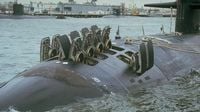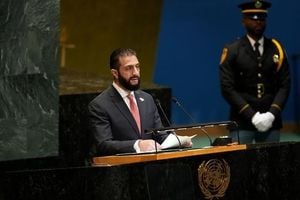As the United States faces the second week of a government shutdown, a new and unsettling warning has emerged from the highest levels of the nation’s nuclear security apparatus. On October 2, 2025, U.S. Energy Secretary Chris Wright sounded the alarm: with just eight days of funding left for the National Nuclear Security Administration (NNSA), the very foundation of America’s nuclear deterrence could be at risk. The NNSA, responsible for overseeing the nation’s nuclear weapons arsenal, as well as the engines that power nuclear submarines and aircraft carriers, is now staring down the barrel of emergency shutdown procedures if Congress does not act soon.
“After those eight days, we will have to go into emergency shutdown procedures that put the country at risk,” Wright declared, as reported by multiple outlets. The government shutdown, which began at 00:01 on October 1, has already disrupted a range of federal operations, but the potential impact on nuclear security has brought a new sense of urgency—and anxiety—to the ongoing standoff in Washington.
The stakes are enormous. The NNSA is not just another federal agency; it is the linchpin of America’s nuclear deterrence, responsible for maintaining, securing, and modernizing the warheads that underpin the country’s defense strategy. Without continued funding, critical maintenance and security operations could be delayed or halted, raising the specter of vulnerabilities in the world’s most powerful arsenal.
According to the National Institute for Public Policy, the timing of this crisis could hardly be worse. In June 2025, a comprehensive report titled A New Strategic Review for a New Age: 2025 was published to inform the incoming administration and Congress about the rapidly deteriorating nuclear threat environment. The study, led by Dr. Keith B. Payne and a team of seasoned defense experts, concluded that U.S. nuclear deterrence policies have remained largely unchanged for years, even as the world has grown significantly more dangerous.
Dr. Payne, a former Deputy Assistant Secretary of Defense and co-founder of the National Institute for Public Policy, explained the gravity of the situation in a recent address at the Hudson Institute. “Continuity is the real hallmark of U.S. nuclear deterrence policy—even as the world has become much more dangerous,” Payne noted, underscoring the disconnect between policy inertia and evolving threats.
Much of the current U.S. nuclear modernization program and the New START Treaty were crafted about fifteen years ago, at a time when relations with Russia and China were seen as relatively benign. The prevailing wisdom was that great power conflict was a relic of the past, and that nuclear weapons were increasingly irrelevant. Non-proliferation, not deterrence, was the priority. But, as Payne and his colleagues point out, this optimism was misplaced. Since then, Russia and China have embarked on aggressive expansions of their nuclear and conventional forces, often in violation of existing treaties.
“Russia has so blatantly violated the New START Treaty that we are unlikely to know Russian strategic nuclear force numbers at this point,” Payne observed, referencing the cessation of on-site inspections and the loss of transparency that once underpinned arms control agreements. According to the National Institute for Public Policy, both Moscow and Beijing now use nuclear weapons not just for defensive deterrence, but as a coercive shield for their expansionist ambitions.
The consequences of these developments are already being felt. Since 2022, Europe has witnessed nuclear coercion in action, and there is growing concern about similar tactics being employed in the Asia-Pacific, particularly with regard to Taiwan. The ripple effects are global: U.S. allies such as South Korea, Japan, Germany, and even Australia are openly debating the development of their own independent nuclear capabilities, a clear sign of eroding confidence in the U.S. nuclear umbrella.
Amid these mounting challenges, the U.S. finds itself constrained by decades of force reductions and an aging nuclear infrastructure. According to the latest figures cited by Payne, the U.S. currently maintains approximately 1,660 deployed strategic nuclear weapons. However, the ability to rapidly strengthen deterrence is limited by the existing number of available bombers, missiles, and warheads—a direct result of what former Defense Secretary Robert Gates called America’s “three decades-long ‘holiday from history.’”
So, what are the options? The A New Strategic Review for a New Age: 2025 study outlines three possible paths for U.S. nuclear deterrence policy. The first is to redefine what constitutes sufficient deterrence, embracing a “less is enough” approach. The second is to maintain the status quo and hope that adversaries do not test American resolve while new systems come online. The third—and, according to the study, most prudent—option is to move forward urgently to strengthen the U.S. nuclear deterrence position.
“Given the heightened threat context, Washington must strengthen the U.S. deterrence posture for the United States and for allies,” Payne argued. The 2023 Strategic Posture Commission echoed this sentiment, using the words “urgent” or “urgently” over forty times in its recommendations. Yet, the reality is sobering. The United States’ ability to boost its nuclear posture in the near term is hampered by the atrophying of its nuclear infrastructure and the slow pace of modernization.
One near-term solution, according to Payne and his colleagues, is “nuclear force upload”—adding existing warheads to existing delivery platforms. This approach, they argue, is both timely and relatively low-cost. “Nuclear weapons upload of legacy and eventually replacement forces is a near-term and likely low-cost option,” the study asserts. Uploading could increase the number of deployed warheads significantly before any new systems become operational, providing a critical stopgap in the face of mounting threats.
But even this option is not a panacea. Arms control advocates continue to push for agreements to limit such uploads, but Payne warns that meaningful arms control with adversaries like Russia, China, North Korea, and Iran is “either impossible or unimportant.” Instead, he argues, the focus must be on strengthening deterrence, including investments in missile defense to protect retaliatory capabilities and nuclear command and control.
As the clock ticks down on NNSA funding and the shutdown drags on, the intersection of political gridlock and nuclear security has never been more fraught. Secretary Wright has also accused Democrats of delaying the appointment of more than twenty key personnel within the Energy Department, further complicating the agency’s ability to respond to the crisis. Meanwhile, Congress has failed to pass a resolution to resume government funding, ensuring that the shutdown will continue into the following week—at least.
The lessons of history, Payne cautions, are clear: “Recognizing where we are, how we got here, and moving quickly to strengthen our position may yet help deter war.” The question now is whether the United States can muster the political will and practical means to shore up its nuclear deterrence before vulnerabilities become catastrophes. With the world’s nuclear balance at a tipping point, the stakes could not be higher.





